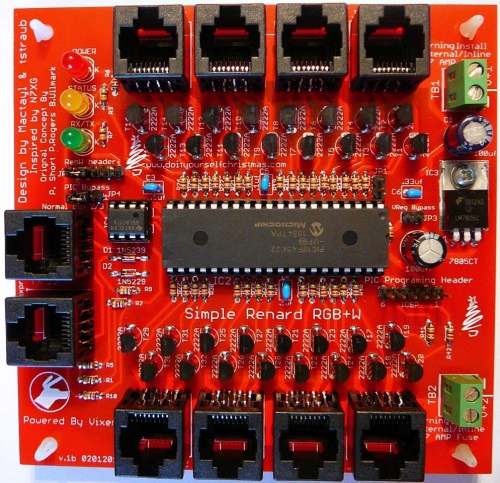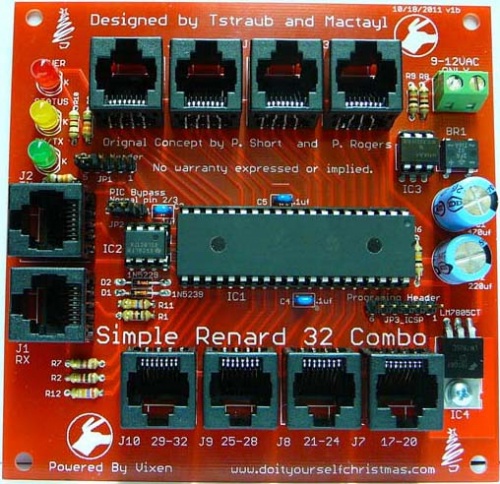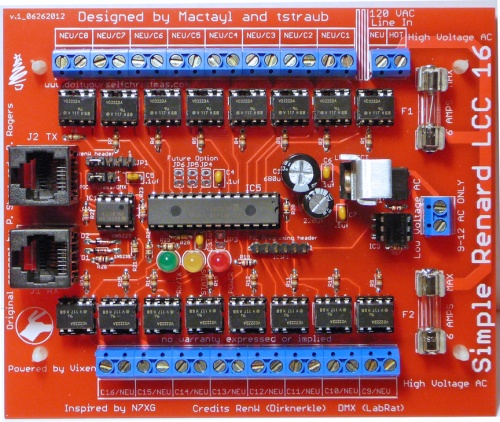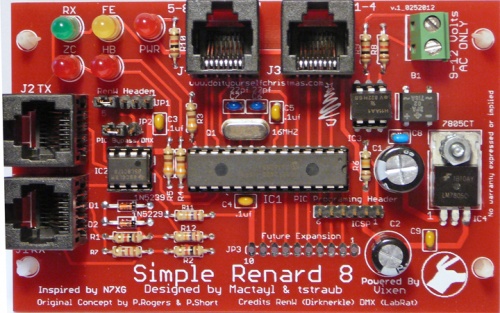The Simple Renard Series: Difference between revisions
(Undo revision 9801 by N7XG (talk)Leave the reference for the SS series to help new users find the right boards. There are a lot of renard boards....) |
|||
| (18 intermediate revisions by 3 users not shown) | |||
| Line 35: | Line 35: | ||
=='''The Different type of Simple Renard Boards'''== | =='''The Different type of Simple Renard Boards'''== | ||
===Simple Renard RGB+W=== | ===Simple Renard RGB+W=== | ||
[[Simple_Renard_RGB%2BW|Simple Renard RGB+W]]<br/> | The Simple Renard RGB+W is a low cost 32 channel DC controller designed to drive low current DC loads like RGB+W LED flood lights (such as DIYC Flood, Mighty Mini or Frank's Super Strip). Unlike other DC designs like the REN48LSD , the Simple Renard RGB+W makes use of a different PIC, the PIC18F4520. This PIC allows 32 chanels per PIC to be controlled compared to the usual 8 channels per PIC (16F688) used in most Renard designs. This allows a smaller board and lower total cost. The design uses low cost NPN bipolar transistors to switch the loads to ground to power the outputs. For more information go to [[Simple_Renard_RGB%2BW|Simple Renard RGB+W]]<br/> | ||
[[File:SR_RGB+W_populated.jpg|500px]]<br/> | [[File:SR_RGB+W_populated.jpg|500px]]<br/> | ||
===Simple Renard 32 Combo=== | ===Simple Renard 32 Combo=== | ||
[[Simple_Renard_32_Combo|Simple Renard 32 Combo]]<br/> | The Simple Renard 32 combo is a low cost 32 channel controller designed to drive either ACSSRs or DCSSRs which switch their loads close to the item being controlled. Unlike other Renard designs like the Renard 64XC, the Simple Renard 32 Combo makes use of a different PIC, the PIC18F4520. This PIC allows 32 chanels per PIC to be controlled compared to the usual 8 channels per PIC (16F688) used in most Renard designs. This allows a smaller board and lower total cost.For more info go to [[Simple_Renard_32_Combo|Simple Renard 32 Combo]]<br/> | ||
[[File:Sr32c_Step9.jpg|500px]]<br/> | [[File:Sr32c_Step9.jpg|500px]]<br/> | ||
<br/> | <br/> | ||
===Simple Renard 24=== | ===Simple Renard 24=== | ||
<br/> | <br/> | ||
===Simple Renard 24/6=== | ===Simple Renard 24/6=== | ||
<br/> | <br/> | ||
===Simple Renard 16=== | ===Simple Renard LCC 16=== | ||
The Simple Renard LLC 16 is a low cost 16 channel controller with integrated ACSSRs designed to drive low power (<0.6A per channel) AC loads. Unlike other Renard designs like the Renard 64XC, the Simple Renard LCC 16 makes use of a different PIC, the PIC18F2525. This design also uses a VO2223 power triac which replaces both the optoisolator and the triac in traditional Renard designs. This allows a smaller board and lower total cost. | |||
<br/> | <br/> | ||
[[File:SRLCC16.jpg|500px]]<br/> | |||
<br/> | |||
===Simple Renard 8=== | ===Simple Renard 8=== | ||
The Simple Renard 8 is a low cost 8 channel controller designed to drive either ACSSRs or DCSSRs which switch their loads close to the item being controlled. Unlike other Renard designs like the Renard 64XC, the Simple Renard 8 makes use of a different PIC, the PIC18F2525. | |||
[[File:SR_8_complete.jpg|500px]]<br/> | |||
<br/> | <br/> | ||
=='''Board Availability'''== | |||
Visit [http://n7xgshop.net/shop/ N7XG Site] for board availability.<br/> | |||
| Line 360: | Line 67: | ||
[[Category:DIYC Controllers]] | [[Category:DIYC Controllers]] | ||
[[Category:Renard]] | [[Category:Renard]] | ||
[[Category:DIYC Index]] | [[Category:DIYC Index]] | ||
Latest revision as of 13:46, 9 March 2013
Introduction
THIS WIKI IS A WORK IN PROGRESS. PLEASE CHECK BACK FOR UPDATES
THIS WIKI IS ABOUT THE SIMPLE RENARD SERIES OF CONTROLLERS, NOT THE SS SERIES OF CONTROLLERS
FOR INFORMATION ABOUT THE SS SERIES OF BOARDS GO TO: SS24 SS16 SS8
- The Simple Renard Series are a PIC microcontroller based Christmas light controllers with 16, 24 or 32 channels that connect to AC SSR's, DC SSR's or DC Floods. The board design is based on the PIC-based 8-port dimmer concept originally developed by Phil Short. Information on the original concept can be viewed here. Generic information pertaining to current Renard designs (including maximum channel count) can be found on the Renard wiki page.
- The Simple Renard Series controllers are part of a design effort to standardize the board layouts for Renard based systems and to establish a standardized list of components to use in Renard designs.
- Common part list used for all boards. There are no special parts for any individual board, all the boards use the same components. The only thing different is the quantity used on each board.
- Common component layout on the board. With only a few exceptions, all the components on the boards are laid out in the same fashion.
- On-board LEDs for status of ZC, HB FE and TX/RX signals.
- Easier for a new member to build. By removing extra options from the board, now a member can just order the parts from the BOM and will be able to build the board without having to figure out which options/parts apply to their configuration.
- Easier to support. By having all the boards using the same parts and having the same component layout, it will be easier to provide support to DIYC members when they have problems or ask questions.
- Complete documentation. In the past, boards were created, designed, produced and distributed without much documentation to support them. Documentation was an afterthought and was slow to catch up, some never did or is hard to understand for new members. In the Renard SS design effort, the documentation was created at the same time as the boards so that when the boards were ready for release, the documentation was also ready.
Disclaimers
- The standard disclaimers pertaining to the information contained on this wiki page are listed here.
The Different type of Simple Renard Boards
Simple Renard RGB+W
The Simple Renard RGB+W is a low cost 32 channel DC controller designed to drive low current DC loads like RGB+W LED flood lights (such as DIYC Flood, Mighty Mini or Frank's Super Strip). Unlike other DC designs like the REN48LSD , the Simple Renard RGB+W makes use of a different PIC, the PIC18F4520. This PIC allows 32 chanels per PIC to be controlled compared to the usual 8 channels per PIC (16F688) used in most Renard designs. This allows a smaller board and lower total cost. The design uses low cost NPN bipolar transistors to switch the loads to ground to power the outputs. For more information go to Simple Renard RGB+W

Simple Renard 32 Combo
The Simple Renard 32 combo is a low cost 32 channel controller designed to drive either ACSSRs or DCSSRs which switch their loads close to the item being controlled. Unlike other Renard designs like the Renard 64XC, the Simple Renard 32 Combo makes use of a different PIC, the PIC18F4520. This PIC allows 32 chanels per PIC to be controlled compared to the usual 8 channels per PIC (16F688) used in most Renard designs. This allows a smaller board and lower total cost.For more info go to Simple Renard 32 Combo

Simple Renard 24
Simple Renard 24/6
Simple Renard LCC 16
The Simple Renard LLC 16 is a low cost 16 channel controller with integrated ACSSRs designed to drive low power (<0.6A per channel) AC loads. Unlike other Renard designs like the Renard 64XC, the Simple Renard LCC 16 makes use of a different PIC, the PIC18F2525. This design also uses a VO2223 power triac which replaces both the optoisolator and the triac in traditional Renard designs. This allows a smaller board and lower total cost.

Simple Renard 8
The Simple Renard 8 is a low cost 8 channel controller designed to drive either ACSSRs or DCSSRs which switch their loads close to the item being controlled. Unlike other Renard designs like the Renard 64XC, the Simple Renard 8 makes use of a different PIC, the PIC18F2525.

Board Availability
Visit N7XG Site for board availability.